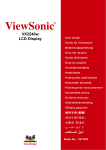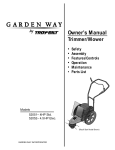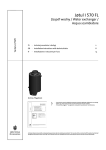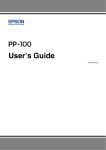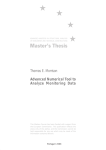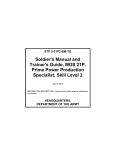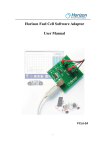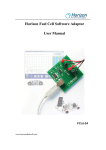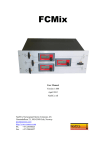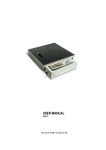Download MOP-X1 User Manual
Transcript
MOP-X1 Corrosion Rate Meter User Manual Version 1.0 English, Grudzień 2012 TERCJA – Systemy Pomiarowe i Komputerowe In case of problems Contact the device’s producer. TERCJA – Systemy Pomiarowe i Komputerowe 80-534 Gdańsk, ul. Starowiejska 63 Poland tel.: +48 340 88 41 fax: +48 340 88 41 e-mail: [email protected] website: http://www.tercja.gda.pl Warranty The MOP-X1 corrosion rate meter is covered by a 2 year limited warranty from the moment of purchase. The warranty does not cover defects resulting through fault of the user. Any signs of mechanical damage along with internal interference will invalidate the device’s warranty. The TERCJA Company reserves the right to change the device’s configuration and the programming of its products without requiring the introduction of these changes to the already purchased products. Any changes can be made without further information. Disclaimer The information contained in this manual has been thoroughly checked and appeared to be correct at the time of the publication of this document. TERCJA Company assumes no responsibility for any errors that may be revealed in the future. Copyright Copyright 2013 by TERCJA – Measurement and Computer Systems All rights reserved. Without the consent of the author, copyright owner and also the publisher, no part of this publication may be reproduced or be relayed in any form or by any means, electronic, mechanical, photocopying, or through other means. TERCJA – Systemy Pomiarowe i Komputerowe TERCJA – Systemy Pomiarowe i Komputerowe 5 MOP-X1 User Manual TABLE OF CONTENTS 1 Introduction ..........................................................................7 2 Technical specification ..........................................................9 3 Meter functions...................................................................11 4 Package contents.................................................................13 5 Measurement sensors.........................................................15 5.1 Dedicated sensor .........................................................17 5.2 Custom sensor .............................................................18 6 Front panel ..........................................................................21 7 Connector ............................................................................23 7.1 8 Preparation for use .............................................................25 8.1 9 Connecting your own sensors .....................................23 Battery replacement ...................................................26 Measurement ......................................................................27 10 User menu ...........................................................................31 10.1 Meter options..............................................................31 10.1.1 Date and time ......................................................31 10.1.2 Automatic shutoff ................................................31 10.1.3 Setting the dispaly and sound..............................32 10.1.4 Resetting to default values ..................................33 10.2 Measurement options .................................................33 10.2.1 Measurement units..............................................34 10.2.2 Automatic measure mode ...................................34 10.2.3 Sensor settings .....................................................35 10.2.4 Environment resistance .......................................38 10.2.5 Electrode order ....................................................38 TERCJA – Systemy Pomiarowe i Komputerowe 6 Table of contents 10.2.6 Calibration ........................................................... 40 10.3 Reading measurements results .................................. 41 11 Measurement results ......................................................... 43 12 Method for calculating corrosion rate ............................... 47 13 Additional adapters ............................................................ 53 13.1 MOP-X1-US ................................................................. 53 13.2 MOP-X1-USB ............................................................... 54 14 References .......................................................................... 55 15 Appendix A – Basics of a method ....................................... 57 TERCJA – Systemy Pomiarowe i Komputerowe 7 MOP-X1 User Manual 1 INTRODUCTION Thank you for your interest in our product. A corrosion rate meter is used to determine the rate at which material diminishes due to corrosion, which is inevitable. The results are given in very simple units of mm / year. This allows you to estimate the life expectancy of an existing installation. The measurement is instantaneous and reflects the corrosion rate at the moment of measurement. As a result, it is possible to test the performance of applied corrosion protection e.g. inhibitors. The meter operates on the generally accepted method of linear polarization (LPR - Linear Polarization Resistance) and is used in conductive environments. It can be used in assessing the corrosion rate of all water pipes made of various metals such as structural steel, stainless steel, brass, copper etc. Should you require the measurement of corrosion rate in nonconductive media such as liquid hydrocarbons or gases we invite you to examine our other products – electrical resistance meter to measure corrosion rate. It also operates on a generally accepted principle – electrical resistance method. The meters can also be produced in a stationary version and, together with sensors, possess the appropriate certificates allowing operation in explosion hazard areas. TERCJA – Systemy Pomiarowe i Komputerowe 8 Introduction TERCJA – Systemy Pomiarowe i Komputerowe 9 MOP-X1 User Manual 2 TECHNICAL SPECIFICATION Power 4 ‘AA’ Batteries Operating time on fully-charged batteries: Up to 400 hours* Standby time Approximately 1 year Power consumption in standby mode: 0.1 mA Power consumption in active mode: 4 mA Power consumption during test: 6 mA Backlight power consumption 6 mA Clock backup time 3 minutes Dimensions (length X width X height) 185 x 80 x 45 mm Weight (without batteries) 570 g Degree of Protection IP67 Display Monochromatic Display 128x64 Signal Sound * when backlight is deactivated TERCJA – Systemy Pomiarowe i Komputerowe 10 Technical specification TERCJA – Systemy Pomiarowe i Komputerowe 11 MOP-X1 User Manual 3 METER FUNCTIONS The MOP-X1 corrosion rate meter contains the following functions: - Corrosion rate measurement using the linear polarization method - Display of measurement results in mm/year (mmpy) or mils/year (mpy) - Temperature measurement if the sensor is equipped with this feature. - Measurement of the quality assessment algorithm (scale 0100) based on multiple parameters, such as the potential difference between the electrodes, voltage and current fluctuations, and the exceeding of ranges, etc. - Automatic signaling for suspected pitting corrosion, and also for damage or measurement sensor wear. - Automatic connection with the measurement sensor and collect from it, data with respect to the test material, geometrical properties and the properties of the corrosive environment. - The ability to change the functions of the individual electrodes in the measurement sensor, and thus executing three independent measurements with one sensor. - The ability to connect your own corrosion sensors and set up data with respect to the test material, geometrical properties, and the properties of the corrosive environment. (OPTIONAL – using an MOP-X1-US adapter) TERCJA – Systemy Pomiarowe i Komputerowe 12 Meter functions - The ability of quick measurements with your own sensors, using the empirical relationship for structural steel and brass. (OPTIONAL – using an MOP-X1-US adapter) - The ability to save up to 100 results in the device’s memory along with a description and allowing their later reading. - The ability to record the results to a computer, export them to a text file, and analyze them in MOPCorr dedicated software. (OPTIONAL – using an MOP-X1-USB adapter) TERCJA – Systemy Pomiarowe i Komputerowe 13 MOP-X1 User Manual 4 PACKAGE CONTENTS The basic set consists of: - MOP-X1 corrosion rate sensor Calibration tip 4 X NiMH 2200mAh batteries Battery charger 4 mm Allen key Instruction Manual Carrying case for the device Optional items in the set include: - MOP-X1-USB Adapter Allows for connection of the meter to a computer - MOP-X1-US Adapter Allows for the use of your own corrosion sensors. TERCJA – Systemy Pomiarowe i Komputerowe 14 Package contents TERCJA – Systemy Pomiarowe i Komputerowe 15 MOP-X1 User Manual 5 MEASUREMENT SENSORS Apart from just the meter, measurement sensors are also necessary in performing measurements; these are also known as corrosion sensors. The most important element of the sensor is the electrodes. It is on them where the corrosion reaction occurs. At least one of the electrodes, that on which the corrosion reaction will be measured, should be comprised of a material for which the corrosion rate is being tested. Naturally, it is most often the metal from which the construction element is made and on which the sensor is mounted. This electrode is called the testing, or working electrode. The remaining two electrodes are an auxiliary electrode and a reference electrode which is also known as the reference. It is most common to find that sensors have three electrodes. Sometimes a dual electrode system is also used, in which the auxiliary and reference electrodes are shorted. In addition to the electrode, the sensor is comprised of a housing on which is most commonly found a thread used to screw in a probe which extends from the structure. Of course, it is possible to apply other methods for installing the sensor on a structure required in a given situation. From the sensor extends a cable which ends in a DIN tip. There should be free access to this tip for the purpose of connecting the MOP-X1 meter and performing a measurement. TERCJA – Systemy Pomiarowe i Komputerowe 16 Measurement sensors An option is equipping the device with a temperature sensor. Then there is the option of simultaneous measurement of the corrosion rate and the temperature, and the results are then correlated and can be read later, and processed. A common practice is to use three electrodes of the same (test) material. This allows for performing up to three measurements on a single sensor, changing the functions of the individual electrodes. As a result, it is possible to average the results of these three measurements. This is of great importance for the sensors already mounted for some time on the installation, since the electrode in such a sensor are covered with various sediments from corrosion and also from the environment. In this case, the electrode continually operating as a test electrode could lose its properties. Changing the function of the electrode allows for a sequential measurement of all the electrodes as testing electrodes. The process for setting up the order of the electrodes is described in chapter 10.2.5. Of course, in the case of sensors where the electrodes are not made of the same material, enabling this feature distorts the results, and, in extreme cases, can lead to the destruction of the electrodes. TERCJA – Systemy Pomiarowe i Komputerowe 17 MOP-X1 User Manual ATTENTION: Averaging the results of the three measurements is not just simply arithmetic averaging. You should consider the quality of each individual measurement. Therefore, if on any electrode configurations the result is of a low quality, then to a lesser degree this will influence the overall result. The concept of the quality of results and averaging algorithm is explained in Chapter 11. The calculation of corrosion rate requires the input of much information with respect to the sensor itself along with the environment in which it operates. This information can be determined once and stored permanently in the sensor so that the meter will be able to use them during each measurement. It is also possible to just enter these parameters manually. It depends on the type of sensor used. Environmental parameters are described in Chapter 12. In the case of the MOP-X1 device, there are two main types of sensors – dedicated sensors and your own sensors. 5.1 DEDICATED SENSOR Dedicated sensors are the basic sensors intended to work with the device itself. Each sensor is constructed for the specific needs of the user. It has the required shape, size, and type of mounting for the structure. The most important thing is that it contains saved electrochemical environmental parameters and information on the type and size of the electrodes used. This information is read from the sensor whilst connected and is used to calculate the correct rate of corrosion. . Amazingly, TERCJA – Systemy Pomiarowe i Komputerowe 18 Measurement sensors it eases work, as it eliminates the need to enter the sensor parameters before each consecutive measurement on another sensor. In the case of using a sensor with a temperature sensor, it is detected automatically, and the result of the temperature measurement is included in the result of the corrosion rate measurement. In Conclusion: With this meter, customers are supplied with the appropriate amount of sensors and the proper required framework. The sensors are configured to work in a specific location. To complete such a configuration, our company needs to be provided with data on the type of metal that makes up the structure at the measurement location, information on the size of the flow or lack of a medium, and preferably a sample of the medium for a laboratory to determine the electrochemical factors of the environment. For customers who wish to use their own corrosion sensors (purchased from another supplier or produced by their own means) this has been provided for. 5.2 CUSTOM SENSOR It is possible to use your own sensors that contain the information about the environment and the electrodes. These are classical sensors from other companies or those made by hand. To be able to use such sensors you need to connect them via a special MOP-X1-US adapter (see Chapter 13). TERCJA – Systemy Pomiarowe i Komputerowe 19 MOP-X1 User Manual In this case, all the information needed to properly determine the corrosion rate should be entered into the meter before measurements. One should know the surface of the test electrode, the environmental resistance, Tafel coefficients for the given metal in the given environment, coefficients associated with the corrosive metal, and the coefficient associated with the distribution of the electrical field between the electrodes. These parameters are described in further detail in Chapter 12; and the basics of electrochemical methods for linear polarization in Appendix A It is necessary to remember, that accurate determination of Tafel coefficients is possible with a professional potentiostat and, in general, they are most conveniently carried out in a laboratory on a sample of the metal and the environment; although in some cases it is possible to assume some approximate values of these coefficients. For convenience, it is possible for the meter to make measurements without entering Tafel coefficients, of which the determination can be difficult. It is a measurement method reserved for measuring ordinary carbon steel, or MC70-type brass in a typical, moderately corrosive water. Incorporating this option is described in Section 10.2.3. This became possible thanks to the empirical formulas given by the Industrial Chemistry Institute in Warsaw. These patterns are the result of the correlative results of more than a hundred different waters with different inhibitors. The use of these empirical models provides an accuracy of 30%, which TERCJA – Systemy Pomiarowe i Komputerowe 20 Measurement sensors very often is an acceptable value. For better accuracy, however, it is necessary to determine the Tafel characteristics, and count the corrosion rate with their help. ATTENTION: Use of empirical formulas only allows the avoidance of entering Tafel coefficients and the alpha coefficients for metal. One should still enter the electrode surface, environmental resistance, and the coefficient of the electrical field distribution between the electrodes (see Chapter 11). ATTENTION: The use of empirical formulas is reserved for measuring the normal corrosion rate of carbon steel or MC70type brass in typical, moderately corrosive water. In the case of using your own sensors you should keep in mind a proper connection to the meter (via adapter MOP-X1-US). It should be noted that the electrodes are hooked up to the appropriate pins on the plug. A description of connections in the case of using your own sensors is presented in Section 7.1. TERCJA – Systemy Pomiarowe i Komputerowe 21 MOP-X1 User Manual 6 FRONT PANEL The diagram presents a front view of the device. The ON/OFF button is used to activate and de-activate the meter. In order to activate or de-activate the device, one should hold the button for approximately three seconds. The buttons ↑↓←→ are used to move to the options menu and set the numerical and letter values. The OK and C keys’ effects are dependent on the options displayed in the lower, extreme positions on the screen. The most frequently used OK button is used to enter the menu and accept the changes, whilst the C button is used to cancel the changes and return to the previous menu. The START button, in effect, is used to start the measurement of corrosion rate, unless another application is indicated on the screen. The meter has a monochrome backlit display with a resolution of 128x64 pixels. TERCJA – Systemy Pomiarowe i Komputerowe 22 Front panel TERCJA – Systemy Pomiarowe i Komputerowe 23 MOP-X1 User Manual 7 CONNECTOR Connectors onnectors used to connect to the measurement device, as well as to connect ect the meter to a computer with the help of a MOP-X1 X1-USB adapter can be found on n the bo bottom of the device. A 6-pin pin screw screwtype DIN 45 322 female connector is used, with an internal thread that assures an IP67 airtight classific classification. Correct connection of the plug and tightening of the screw allows for protection against the entry of water and protection against IP67 solid bodies. ATTENTION: During connection of any additional devices to the meter, the message CONNECTION should appear on the screen. Upon disconnection disconnection, the message DISCONNECT will appear. In the case of any other type of problem with the additional device the message FAILURE will appear on the screen. 7.1 CONNECTING YOUR OWN S SENSORS By using an MOP-X1-US adapter adapter, it is possible to use your own corrosion sensors. The sensors should be tri-electrode. One electrode should be made of the same metal as the metal being measured and is referred to as the tested electrode. The TERCJA – Systemy Pomiarowe i Komputerowe 24 Connector remaining two are respectively referred to as the reference electrode (reference) and the auxiliary. With the plug design, one should know that the sensor electrodes should be connected to connector pins 1, 2 and 3. The meter offers the possibility of switching the electrode’s function as described in section 10.2.5. With respect to the above, each configuration of the electrode’s individual pins on the connector also changes their function. Configuration A Pin 1 – working electrode Pin 2 – reference electrode Pin 3 – auxiliary electrode Configuration B Pin 1 – reference electrode Pin 2 – auxiliary electrode Pin 3 – working electrode Configuration C Pin 1 – auxiliary electrode Pin 2 – working electrode Pin 3 – reference electrode TERCJA – Systemy Pomiarowe i Komputerowe 25 MOP-X1 User Manual 8 PREPARATION FOR USE The device communicates with the user only in English. Even so, the interface was prepared in such a way, to make it simple and intuitive. Before its first use, the meter should be calibrated; the correct date and time should be set. When you activate the device, it will prompt you to perform these activities. You can also do it yourself. These options are respectively: MENU → MOP SETTINGS → DATE/TIME MENU → MEASURE SETTINGS → MOP CALIBRATION The procedure for setting these options is described in Sections 10.1.1 and 10.2.6. ATTENTION: You should be careful in the correct setting of the date and time to maintain a continuous series of measurements. ATTENTION: An incorrect calibration may lead to erroneous measurement results. TERCJA – Systemy Pomiarowe i Komputerowe 26 Preparation for use 8.1 BATTERY REPLACEMENT The meter is powered by four AA batteries (big finger). Both conventional alkaline batteries with a voltage of 1.5 V and batteries with a voltage of 1.2 V can be used. A fully charged battery with a capacity of 2200 mAh allows up to 400 hours of use. In the case of nearing the moment of battery depletion, the message LOW BATTERY will be displayed in the upper left corner of the display. To replace the battery, remove the black round caps and unscrew the two screws indicated in the figure below. To loosen them, use a 4mm Allen key. ATTENTION: To maintain an IP67 airtight classification, after replacing the batteries, you should tighten the casing. ATTENTION: After removal of the batteries for a period longer than the standby, it may be possible that the correct date and time settings may disappear. In such a case, the device will inform of this upon start-up. TERCJA – Systemy Pomiarowe i Komputerowe 27 MOP-X1 User Manual 9 MEASUREMENT After activating the meter with the ON/OFF button, one may immediately begin performing measurements. After connecting the meter to a properly installed corrosion sensor the meter will detect its presence: The word CONNECTION will appear on the screen, and after a short time, if the sensor connections are correct – the message SENSOR DETECTED. At this point it is possible to review the information stored in the sensor, scrolling through the screens by pressing MORE. The Information will include the sensor and its serial number, the material from which the sensor is made, the active surface of the electrodes, and the environmental resistance and electrochemical coefficients specifically designated for the sensor and its mounted location. To begin the measurement, click the large START button on the keypad. At this point the device begins a measurement or a series of measurements (depending on the setting of the order of electrodes - see section 10.2.4). When the progress bar reaches the end, the value of the corrosion rate and the estimated quality of the measurement will be displayed on the screen. At this moment it is also possible to see a report on the measurement sequence. The device can detect any irregularities associated with the measurement. To view the report, although it is not written on the screen, press the large START TERCJA – Systemy Pomiarowe i Komputerowe 28 Measurement button. Therein will be contained messages informing of both correct operation and noted irregularities. To scroll through these information pages you should press MORE. More about these messages and measurement quality can be found in Chapter 11. Once a measurement has been taken, you can save the measurement result in the device’s memory under any name. As a default, when entering the name of the measurement, the most recently entered name appears. For convenience, it is suggested that the name consist of a descriptive part and a sequential number such as "valve 1 - 1", "valve 1 - 2", "valve 1 - 3", etc. To move between lettered fields, you should use the ←→ keys. Yet, to select a respective symbol, you should use the ↑↓ keys. One can easily and automatically record to a PC. To connect the meter to a computer via USB one needs an MOP-X1-USB adapter. The included software allows you to collect and export the results to a text file. For each result, the sensor number is stored which thus allows one to independently follow the progress of corrosion for each individual sensor. MOPCorr software is also included, allowing for data visualization. TERCJA – Systemy Pomiarowe i Komputerowe 29 MOP-X1 User Manual ATTENTION: The meter contains memory for the last 100 measurements. Further results are recorded in the next available space. At the moment of exhaustion of all of the available space the oldest results are overwritten. Keep this in mind so as not to lose the oldest, and yet to be archived, measurement results. TERCJA – Systemy Pomiarowe i Komputerowe 30 Measurement TERCJA – Systemy Pomiarowe i Komputerowe 31 MOP-X1 User Manual 10 USER MENU The device has a menu where you can set options for the meter, measurement options, and read recorded measurement results. 10.1 METER OPTIONS It is possible to set the following parameters associated with this meter. 10.1.1 DATE AND TIME To set the date and time you should sequentially enter: MENU → MOP SETTINGS → DATE/TIME There, use the ←→↑↓ keys to set the correct date and time. The date should be re-set after each battery change. In the case of incorrect settings, the meter itself informs you of the necessity of settings during start-up. ATTENTION: One should maintain the correct date and time settings to keep a continuous series of measurements. 10.1.2 AUTOMATIC SHUTOFF It is possible to activate an automatic shut-off feature in the meter, which turns it off the after a set period of time. To do this, next enter: TERCJA – Systemy Pomiarowe i Komputerowe 32 User menu MENU → MOP SETTINGS → AUTO OFF Set the ACTIVE feature to ON. The TIME parameter corresponds to the time after which the meter should turn off. The time is measured in minutes. The possible values are: 1, 2, 3, 4, 5, 7, 10, 15, 20, 30, 45 and 60. 10.1.3 SETTING THE DISPALY AND SOUND In this menu, you can set the display contrast, the backlight time, and enable or disable sounds. MENU → MOP SETTINGS → DISPLAY & SOUND The contrast is set by changing the CONTRAST setting to the range 0 - 60. The Backlight time is set by changing the BACKLIGHT setting. It is possible to turn it on permanently (ON), turn it off completely (OFF), or set if for a certain period. The possible values are: 5, 10, 20, 30 seconds; and 1 or 5 minutes. ATTENTION: Working with a fully backlit meter consumes twice as much power than when working with the backlight off entirely. As a result, the maximum operating time is reduced to approximately 200 hours. TERCJA – Systemy Pomiarowe i Komputerowe 33 MOP-X1 User Manual It is possible for the meter to emit a short sound signal. The possible values for the BEEP option are: OFF – no sound MEASURE – sound signal after completing a measurement. KEYS – sound signal when keys are depressed. BOTH – sound signal when keys are depressed and upon measurement completion. 10.1.4 RESETTING TO DEFAULT VALUES To reset the meter to default values, one should sequentially enter: MENU → MOP SETTINGS → LOAD DEFAULTS To the question "ARE YOU SURE TO LOAD DEFAULTS?" one should confirm by pressing OK. The meter will be returned to its default values. 10.2 MEASUREMENT OPTIONS Using these options, it is possible to set measurement parameters such as environmental characteristics and the sensor used. During standard use, the only available options from the entire menu are the options for automatic measurement mode and electrode order. By using an adapter, you can activate the other options (see the information in the boxes). TERCJA – Systemy Pomiarowe i Komputerowe 34 User menu 10.2.1 MEASUREMENT UNITS The meter can present the rate results in two units - mm / year or mils / year. To select the displayed units, one should enter: MENU → MEASURE SETTINGS → MEASURE MODE Set the respective UNITS option. The possible settings are: mmpy – millimetres per year mpy – one thousandth of an inch (mils per year) ATTENTION: Setting this option only affects the display of the results. Results are always stored using the mmpy unit in the meter’s memory. When setting the units to mpy, the results are converted to mpy for the purpose of displaying them on the screen only. 10.2.2 AUTOMATIC MEASURE MODE It is possible to set the meter so that it performs a measurement by itself at a specified time interval. To do this, one should sequentially enter: MENU → MEASURE SETTINGS → MEASURE MODE Then, set the MODE option to AUTO and define how many hours the meter should automatically awaken and perform a measurement. This time is set via the INTERVAL option. The possible values are: 1, 2, 4, 6, 8, 12, 24, 48, 72 and 96 hours. TERCJA – Systemy Pomiarowe i Komputerowe 35 MOP-X1 User Manual The final step is to set the hour of the first measurement– START option. Measurements are performed in a daily cycle, which means that during the first 24 hours the first measurement will be performed at the hour set in the START option. In a case where the setting of time between measurements exceeds 24 hours, the measurements will be performed at the hour set in the START option, every 2, 3, or 4 days. ATTENTION: All measurements are automatically stored in memory under the name AUTOMEASURE. To disable the automatic measurement mode, one should set the MODE option to MANUAL. 10.2.3 SENSOR SETTINGS In the case of using your own measurement sensors, one should define their parameters so that the corrosion rate will be properly calculated. ATTENTION: These options are only available with an additional MOP-X1-US adapter, which allows you to connect any custom sensor and set all its parameters. In the case of an absence of this adapter, the meter automatically downloads the information from a compatible sensor and bases its measurement on it. The possibility to change the above options is then inactive, and some of them remain invisible. TERCJA – Systemy Pomiarowe i Komputerowe 36 User menu To get to the sensor settings, one should next enter: MENU → MEASURE SETTINGS → SENSOR SETTINGS It is possible to configure: AREA - allows you to set the surface of the test electrode. The maximum value is 600.00 cm2. MATERIAL – allows the setting of the method of determining the corrosion rate. The meter is able to use empirical formulas developed on the basis of years of observation. In the case of measuring the corrosion rate of St3S-type structural steel in standard tap water, one can choose the STEEL option. When performing measurements on the corrosion rate of brass in tap water, one can choose the BRASS option. Measuring the corrosion rate of practically any metal can be done by selecting the COMMON option. The meter then uses the theoretical correlation of the underlying theoretical linear polarization technique. In this case, however, one needs to know the appropriate electrochemical properties of the environment, which should be determined by another electrochemical method, such as using Tafel constants. These properties are: - Ba – Tafel anodic coefficient. Range 0 – 6000 mV. - Bc – Tafel cathodic coefficient. Range 0 – 6000 mV. - ALPHA – coefficient associated with corrosive metal Range 0 – 60000. - GEOM – electrical field distribution coefficient. Range 0 – 6000. TERCJA – Systemy Pomiarowe i Komputerowe 37 MOP-X1 User Manual The importance of the above parameters, as well as empirical formulas, is described in Chapter 12 – Method for calculating corrosion rate. ATTENTION: These parameters are only visible after connecting an MOP-X1-US adapter. Without it, one can only see the size of the electrode surface permanently stored in the dedicated sensor, and the electrochemical properties of the environment stored in the sensor can be seen when connecting the sensor to the meter (see Chapter 9). 1 With the use of an MOP-X1-US adapter, measurements are possible when using any corrosion rate sensor, including those produced by you. The possibility of using empirical formulas for setting the MATERIAL option to STEEL or BRASS, exempts one from having to know the above electrochemical coefficients. Actually, one most frequently measures common St3S structural steel or similar non-alloy steel in environments with aggressiveness similar to that of tap water. In such a case, the possibility of using the STEEL setting greatly simplifies measurements on non-standard electrodes. ATTENTION: Setting the MATERIAL option on STEEL or BRASS further requires the defining of the electrode surface as well as environmental resistivity (see section 10.2.4). TERCJA – Systemy Pomiarowe i Komputerowe 38 User menu 10.2.4 ENVIRONMENT RESISTANCE In the case of using non-standard sensors one should know the resistance between the electrodes. Its value can be estimated or determined. To determine it, one should measure the resistivity of the environment, for example, with a conductometer, and then calculate the value of resistance on the section between the surfaces of the electrodes. Setting a value significantly lower than a real one may result in a large measurement error, or the inability to complete the measurement. To set an appropriate value, one should next enter: MENU → MEASURE SETTINGS → ENVIRONMENT SETTINGS Set RESISTANCE. The range of setting is 0 – 60 000 Ω. ATTENTION: The changing of this parameter is only possible by using your own sensor. Standard sensors have the value permanently stored, and in such a case this menu you can only preview without the possibility of editing. 10.2.5 ELECTRODE ORDER This is a setting of the previously mentioned sensor setup menu (see Section 10.2.3). It has been described separately as the menu can only be changed when an MOP-X1-US is not connected. The measurement sensor is in most cases composed of three electrodes. One of them (the test electrode) is made of the material being tested, the other (the reference electrode and TERCJA – Systemy Pomiarowe i Komputerowe 39 MOP-X1 User Manual auxiliary electrode) are also usually of the same material. In such a case, it is possible to exchange the functions of the individual electrodes and conduct three measurements, where each electrode will make its own measurement. This approach allows the extraction of an average corrosion rate value from three measurements. This is often the best solution as over time, the electrodes wear and with some configurations, can produce results of poor quality. To access these electrode settings, one should next enter: MENU → MEASURE SETTINGS → SENSOR SETTINGS Here, one should change the CONFIG option. Possible settings are A, B, C and ALL. The ALL option performs a sequential measurement on all configurations and provides an averaged result. The remaining options are used to include just one particular configuration of electrodes called A, B or C. ATTENTION: In the case of using the ALL option, the averaging of the results from the three measurements is not just simple arithmetic averaging. The quality of the individual measurements is also taken into account. Therefore, when with any of the electrode configurations the result is of a low quality, to a lesser degree it will have an influence on the overall result. The concept of result quality and averaging algorithm is explained in Chapter 11. TERCJA – Systemy Pomiarowe i Komputerowe 40 User menu ATTENTION: The ALL option is turned on by default and is recommended, but only under the assumption that all of the sensor electrodes being used are made of the same material. When the electrodes that are used are made of different materials, which is possible in certain specific applications, one should perform the measurement on a single and appropriate setting. Using the ALL option can cause incorrect results during averaging. 10.2.6 CALIBRATION After each battery replacement the device should be calibrated. Calibration means short-circuiting with each other, the tips of three measurement electrodes. To simplify this, a calibration tip is included in the set supplied with the meter. To calibrate the meter, one should next enter: MENU → MEASURE SETTINGS → MOP CALIBRATION Next, put on the calibration tip and press the CALIBRATE button. ATTENTION: Improper calibration can result in incorrect measurement results. TERCJA – Systemy Pomiarowe i Komputerowe 41 MOP-X1 User Manual 10.3 READING MEASUREMENTS RESULTS In this menu, you can review the recorded corrosion rate measurements. The menu can be navigated by using the ↓ and ↑ keys. Saved data includes: - Measurement name (entered by the user) Date and Time of Measurement Measurement Result Measurement Quality Temperature (when the sensor was used with a temperature sensor) TERCJA – Systemy Pomiarowe i Komputerowe 42 User menu TERCJA – Systemy Pomiarowe i Komputerowe 43 MOP-X1 User Manual 11 MEASUREMENT RESULTS Corrosion rate can be ideally determined by measuring with new, clean electrodes in good laboratory conditions. The working environment of real sensors strongly deviates from laboratory conditions. The electrodes sometimes get covered with corrosion products and the results of the measurements can vary. The ability to assess the accuracy of a measurement is essential. The MOP-X1 meter has been implemented with an innovative method for evaluating the quality of a performed measurement. After each measurement, its quality is calculated as a number in the range from 0 to 100. The quality of a measurement is determined based on a number of factors automatically measured before the actual performing of the measurement. These include the value of the potential between the electrodes, both potential and current fluctuations, any exceeding of measurement ranges, etc. This data, apart from it use in calculating the quality of the result, are also used to inform the user about the correctness of the measurement. This information is available immediately after performing the measurement (see Chapter 9). Possible information is: TERCJA – Systemy Pomiarowe i Komputerowe 44 Measurement results Current values in range in all measured configurations. This message states that the values of the current measurement are in the range of the measuring device. Voltage values in range in all measured configurations. This message states that the values of the potential measurement are in the range of the measuring device. General corrosion observed in all measured configurations. This is a correct message indicating that the corrosion being monitored has the form of general corrosion, and therefore that to which is adapted the linear polarization method. In the case of potential fluctuation where corrosion pitting overlap is suspected, the device will communicate the message Pitting corrosion observed and skips such a result. Normal anode current in all measured configurations. Information states, that the current direction is consistent with the direction of polarization (positive polarity, positive current). When poorly defined starting potential, such as those arising from large fluctuation, it may happen that the current will have a negative value, which will disqualify such a result. TERCJA – Systemy Pomiarowe i Komputerowe 45 MOP-X1 User Manual Proper environment configurations. parameters in all measured This message states that the environmental resistance is not set to a value which is too low. The information above is displayed when there are no problems with the configuration of all the electrodes (A, B and C). Otherwise, the device will inform about specific problems with the configurations in which they occur. As a result, it is possible to quickly detect problems with the sensor or the measurement destabilizing factors (e.g. local corrosion). Yet another message which may be displayed is Electrodes disconnected. This message states that the electrodes are not connected. This signals that there is a physical problem with the sensor connection (e.g. damaged cable) or the actual electrode tips in the sensor housing. ATTENTION: The above information is displayed on the screen immediately after performing the measurement, albeit being stored in memory together with rate results. There is no possibility of seeing them in the result browser menu. Access to this data is possible after recording the results to a computer. It is then possible to observe the result history together with noticed problems, which allows quick assessment of the nature of problems encountered while monitoring corrosion. TERCJA – Systemy Pomiarowe i Komputerowe 46 Measurement results As previously mentioned, for each result its quality is provided. This quality is in the range of 0 to 100, and is calculated based on several factors. As a result, it becomes possible to orientate how reliable the result is. Observing the trend of quality is equally essential. If it drops it usually implies the need for sensor replacement due to wear. In the case of using three consecutive measurements on the same sensor with an exchange of the functions of the individual electrodes as described in Section 10.2.5, the results are averaged, yet this averaging is weighed, where the weight is the quality of each of the individual measurements involved. As a result, the final result will be influenced by these measurements, or measurement, which has the highest quality. Average score also has its average quality. This is done using the below general equations. = ∙ + ∙ + = , , + + ∙ (11.1) (11.2) A single result which has quality equal to zero has no influence on the overall result. The higher the quality, the more each measurement will have an impact on the averaged result. For this reason, it is worth using the function of performing measurement on the following configurations. Averaging the three results gives a more reliable result. TERCJA – Systemy Pomiarowe i Komputerowe 47 MOP-X1 User Manual 12 METHOD FOR CALCULATING CORROSION RATE Presented below is the correlation used to determine the corrosion rate in the classical way (using Tafel coefficients). Empirical formulas (see Section 5.2) have not been cited. Corrosion rate is directly proportional to the so-called corrosion current , the coefficient associated with a corroding metal , and the inverse of the surface area. = S (12.1) Measurement of the corrosion rate relies on producing excitement between the electrodes in the form of the voltage difference and measuring the value of the current induced by the excitation. Knowing the value of the excitation and its response, it is possible to determine the polarization resistance . = (12.2) In fact, the polarization resistance value is influenced by the so-called ohmic drop , which occurs during the flow of current through the resistance. In the case of measuring LPR resistance there is electrolyte resistance , that is, the liquid in which the measurement is performed. TERCJA – Systemy Pomiarowe i Komputerowe 48 Method for calculating corrosion rate = − (12.3) Knowledge of the electrolyte resistance between the electrodes is essential to perform a correct measurement. The dedicated sensors are ready for the environment and have these values stored within it. In the case of using one’s own sensors it is necessary to input the resistance into the settings (see section 10.2.4). The ohmic drop is also influenced by electrode placement relative to each other. One should therefore take into account the geometric coefficient . = − (12.4) The most used sensors are those in which the electrodes are arranged at the vertices of an equilateral triangle. In this case, the geometrical coefficient takes the value of 0.5. As in the previous case, the dedicated sensors have this parameter stored within, while for one’s own sensors it should be entered in the settings (GEOM coefficient - see section 10.2.3). The corrosion current is directly proportional to the corrosion rate (equation 12.1) and is determined from Ohm's law using the following correlations: = (12.5) The parameter itself has the same voltage dimensions and is associated with the specific environment. TERCJA – Systemy Pomiarowe i Komputerowe 49 MOP-X1 User Manual = 2,303 + (12.6) Found in the equation are and coefficients and Tafel coefficients, the anodic and cathodic, respectively. These coefficients are determined through the laboratory testing of the given metal in the environment in which it operates. As with the previously mentioned parameters, the dedicated sensors have the coefficients stored within, and as a result are ready to operate in a specific environment. In the case of using one’s own sensors you should estimate the Tafel coefficients themselves. Before taking a measurement they should be entered into the device settings (parameters Ba and Bc - see Section 10.2.3) ATTENTION: Because of the difficulty in determining Tafel coefficients, in certain circumstances, it is possible to perform a measurement without any knowledge of them, by using empirical formulas. More information can be found in Section 5.2. Another essential parameter of equation 12.1 is the coefficient associated with the corroding metal . It is dependent on the electrochemical equivalent of the metal ! and the metal density ". = 3,27 " ! (12.7) TERCJA – Systemy Pomiarowe i Komputerowe 50 Method for calculating corrosion rate The model shows the constant value 3,27 defining the corrosion rate unit. In this case, it is millimeters per year (mmpy – millimeters per year). ATTENTION: One should always calculate the value of the corrosion rate in mmpy because the device stores the results in this particular unit and has the ability to convert them to other units. The electrochemical equivalent of the metal ! is dependent on the molecular weight of the corroding metal $% and the quantity of electrons & that are exchanged during the oxidation reaction (galvanic corrosion). ! = $% & Below is an example of calculating the coefficient and the corrosion rate millimetre/year: = 3,27 ∙ '( 7,86 ) = 11,65 (12.8) for iron (12.9) Similar calculations for brass produce the value 12,28. In dedicated sensors, the coefficient associated with the corroding metal , is stored permanently. For one’s own sensors one should calculate it according to the above calculation and input it into the setting (ALPHA parameter - see Section 10.2.3) TERCJA – Systemy Pomiarowe i Komputerowe 51 MOP-X1 User Manual The corrosion rate calculated in the above-noted way should be adjusted by the amount of the surface corrosion, that is, the electrode surface area as the test electrode. This is the .parameter in equation 12.1. It is given in /0). For one’s own sensors this size should be input into the settings (AREA parameter - see section 10.2.3). TERCJA – Systemy Pomiarowe i Komputerowe 52 Method for calculating corrosion rate TERCJA – Systemy Pomiarowe i Komputerowe 53 MOP-X1 User Manual 13 ADDITIONAL ADAPTERS The meter can be connected to additional equipment in the form of an adapter (adapters). We currently offer two such devices. 13.1 MOP-X1-US This adapter allows for the use of non-standard corrosion sensors. Standard sensors provided by our company automatically communicate with the meter. Contained within them is information concerning the sensor, such as the electrochemical values associated with the test metal or environmental electrochemical parameters of the sensor’s environment are used to calculate the corrosion rate, and releases the user from the necessity of their individual input on each occasion. However, should the need arise to use a custom sensor, for example, made on your own, one can disable the automatic configuration mechanism by connecting one’s sensor to an MOP-X1-US adapter. In this case, one should input all the environmental parameters. To do this, activate the relevant option in the user menu. This has been described in Section 10.2.3. After connecting the adapter to the meter this message should message should be displayed - CONNECTION, and after a short time - ADAPTER DETECTED. TERCJA – Systemy Pomiarowe i Komputerowe 54 Additional adapters 13.2 MOP-X1-USB This adapter allows one to connect the meter to a computer to record data. Connection is made by a USB interface. The included software allows you to archive measurement results and grouping them depending on the sensor number. In this way it is possible to observe corrosion rate values for each sensor separately for any length of time. Results can be saved in the form of a table in a text file making them easy to visualize with any software that creates charts or with the dedicated MOPCorr software. After connecting the MOP-X1-USB adapter to the meter it will not indicate any action. It is not until it is entirely connected to a computer and initiating a connection with software that the message CONNECTION will appear on the meter’s display, an after a short time the message PC-LINK DETECTED. At this point, you can save data with the MOPCorr software. We cannot exclude the fact that in the future new adapters may appear that offer additional functionality. For further information we encourage you to contact our company. TERCJA – Systemy Pomiarowe i Komputerowe 55 MOP-X1 User Manual 14 REFERENCES [1] Koryta J., Dworak J., Bohackova V., Elektrochemia. PWN Warszawa 1980 [2] Kisza A., Elektrochemia: Tom I Jonika. WNT Warszawa 2001 [3] Kisza A., Elektrochemia: Tom II Elektrodyka. WNT Warszawa 2001 [4] Krakowiak S., Korozja wżerowa (ćwiczenia laboratoryjne). Gdańsk 1995 [5] Pourbaix M., Wykłady z korozji elektrochemicznej. PWN Warszawa 1978 [6] Stern M., Geary A. L., Electrochemical Polarization: I. A Theoretical Analysis of the Shape of Polarization Curves.Journal of the Electrochemical Society, Vol. 104, No. 1, 56-63, 1957 [7] Stern M., A Method For Determining Corrosion Rates From Linear Polarization Data. Corrosion, Vol. 14, No. 9, 1958, pages 440t-444t [8] Jurak K., Projekt urządzenia do wielopunktowego badania szybkości korozji w warunkach przemysłowych metodą polaryzacji linowej, Politechnika Gdańska 2008 TERCJA – Systemy Pomiarowe i Komputerowe 56 References TERCJA – Systemy Pomiarowe i Komputerowe 57 MOP-X1 User Manual 15 APPENDIX A – METHOD BASICS The linear polarization method for measurement of corrosion rate relies on electrochemical reactions. Therefore, before explaining the method itself, this chapter will discuss the electrochemistry basics that are required to understand the issue. A.1 INTRODUCTION TO ELECTROCHEMICAL METHODS Electrochemical methods are based on the study of redox processes in relation to the environment in which we are interested. Oxidation and reduction reactions accompany a clear flow of charge between reactive substances. In general, the process of corrosion depends on the oxidation of the metal according to the reaction below: $1 2 → $1 45 + &1 6 (A.1) The resultant process of the release of electrons is the formation of an electric current. What is easily noticed is that the amount of transferred electrons and thus the value of the current is directly proportional to the amount of metal that has oxidized. This current is called the corrosion current and is named Icorr. If its value is divided by the surface area of the corroding metal (electrode surface area) then we get a value of the corrosion current density named jcorr. TERCJA – Systemy Pomiarowe i Komputerowe 58 Appendix A – Method basics 7 = 8 (A.2) where: 8 - electrode surface area From its value, it is possible to calculate the mass of oxidized metal. Used for this purpose is the well-known and common Faraday's Law, which associates the amount of transferred charge and the amount of the substance that has oxidized or reduced. = 9&: (A.3) where: - charge associated with corrosion current, C 9 & - number of electrons exchanged during the process - mole count of the substance which created or reacted : - Faraday Constant (load of one mole of electrons), 96485= ∙ 0>? 6@ Unfortunately, there is no possibility of directly measuring the corrosion current, since for this purpose one would have to place an ammeter between the oxidation molecule and the TERCJA – Systemy Pomiarowe i Komputerowe 59 MOP-X1 User Manual reduction, which is obviously unrealistic. Fortunately, it is possible to indirectly determine this value by measuring changes in the electrical parameters of the test system (potential, current flowing through the working electrode). Thanks to the electrochemical method there exists a possibility to obtain an instantaneous corrosion rate value and not, as in the case of non-electrochemical methods, averaged values over time, which will be explained later in this work. A.2 EQUILIBRIUM POTENTIAL ER AND CORROSION POTENTIAL ECORR To further discuss methods for measuring corrosion rate we should begin by recalling the basic facts in the field of electrochemistry. For instance, when an iron plate is immersed in a solution of iron ions, the plate will gain an electric potential. It is associated with the reactions that occur. The oxidation of iron takes place: :1 2 → :1 )5 + 21 6 (A.4) That is, metallic iron releases ions into the solution, and leaves electrons in its crystal lattice, which obviously gives the plate potential. One should not forget that every chemical reaction is accompanied, to a greater or lesser degree, by a reverse reaction: TERCJA – Systemy Pomiarowe i Komputerowe 60 Appendix A – Method basics :1 )5 + 21 6 → :1 2 (A.5) In the case of the discussed system the reverse reaction rate is so large that one can speak of thermodynamic equilibrium. That is to say, simultaneously with the oxidation of iron, its reduction also equally occurs. The reaction rate of both is described as a kinetic equation: A C =B =B A ∙= C ∙= C A (A.6) (A.7) where: A, C B A, B C tion rates - oxidation and reduction rates - coefficients of the oxidation and reduction reac- - molar concentrations of the oxidized and re= A, = C duced forms After a while, the rates will equalise: A = C (A.8) Simultaneously therefore, the same amount of iron will be oxidized as will be reduced. The system obtains a state of thermodynamic equilibrium. Observing this at the macro level, it is possible to get the impression that the iron dissolution reaction stopped after a while because the plate no longer TERCJA – Systemy Pomiarowe i Komputerowe 61 MOP-X1 User Manual reduces its mass, and the concentration of Fe2+ ions does not change. Under such conditions as previously mentioned, the potential does not change, so it is called the equilibrium potential Er. Its value can be calculated using the Nernst equation: = 2 + D E ?& 9: E A C (A.9) where: - equilibrium potential, V - standard potential, V, for Fe/Fe2+ is -0.76V 2 - universal gas constant, 8,31 J∙mol-1∙K-1 D E E - temperature, K A C - activity of the oxidized form, in this case Fe2+ ions - activity of the reduced form, in this case iron plate Without any objection, at low concentrations of substances one can assume that the active ions are equal to the molar concentrations, and the activity of the solid metal is always equal to 1, thus equation (A.9) simplifies to the form: = 2 + D ?&/ 9: A (A.10) TERCJA – Systemy Pomiarowe i Komputerowe 62 Appendix A – Method basics Considering corrosion processes, which in most cases differ from the above-noted simple example, imagine therefore, that the opposite reaction to oxidation is not the reduction of Fe2+ to Fe, but the reduction of another substance, known as a depolarizer. Such depolarizers are all molecules capable of receiving electrons, and so very often, for example in water hydrogen cations, oxygen reduces itself according to the equations: 2F) G + 21 6 → F) + 2GF6 (A.11) 2F5 + 21 6 → F) (A.12) G) + 4F5 + 41 6 → 2F) G G) + 2F) G + 41 6 → 4GF6 (A.13) (A.14) In such a case, it is also possible to mention thermodynamic equilibrium, since the rates of the oxidation of iron and the rate of the depolarizer reduction are equal. Unfortunately, the electrons produced in the oxidation of iron (A.4) do not cause its re-reduction (A.5), and that is why it can be stated in very simple terms, that the iron plate gradually disappears, passing into the solution. However, in such a system with a depolarizer, it constantly retains certain potential, called the corrosion potential Ecorr, which is a special case of equilibrium potential. It is also called mixed potential, because the oxidation process and the depolarization process equally have influence on its value. TERCJA – Systemy Pomiarowe i Komputerowe 63 MOP-X1 User Manual To sum up, metal found in an electrolytic corrosive environment irreversibly changes into an oxidized state, that is to say, corrodes and obtains a certain potential called corrosion potential, and depends on many factors - the type of metal, the qualitative and quantitative composition of the corrosive environment, and temperatures. A.3 EXCHANGE CURRENT IO AND CORROSION CURRENT ICORR In section A.1 it was written, that a redox reaction accompanies the flow of charge, where the carrier is electrons, and we therefore have to deal with the flow of electric current. During equilibrium potential, the oxidation rate is the same as the reduction rate, that is, the current associated with the oxidation reaction, called the anode current Ia is identical to the value of the current associated with the reduction reaction – the cathode current Ic. The current flowing at equilibrium is called the exchange current I0. Electrochemistry has adopted a way to distinguish the anode from the cathode current, by treating the anode current as positive, while the cathode current as negative. Therefore, the value of exchange current is equal to the absolute value of the anodic or cathodic current during equilibrium potential: 2 =| |=| | (A.15) TERCJA – Systemy Pomiarowe i Komputerowe 64 Appendix A – Method basics Something can also be said about the value of the resultant current, which is the sum of the anodic and cathodic current values: = = (A.16) Of course, in the case of equilibrium potential, if the anodic and cathodic currents are equal in value, but opposite as to their character, then the resultant current is zero: = = =0 (A.17) When metal is oxidized, but another substance is reduced and equilibrium is determined during a certain corrosion potential Ecorr, we also have to deal with current exchange. In this case, however, this current is called the corrosion current Icorr. In each electrochemical study, there is the obvious aim of precisely determining this value because, as was previously mentioned, the corrosion current density is directly proportional to the corrosion rate, and just calculating the rate of loss comes down to the simple use of Faraday's Law. A.4 OVERPOTENTIAL, POLARIZATION CURVES, BUTLER-VOLMER EQUATION The state of equilibrium can be easily upset, for example, it is enough that an external current is connected to a system in equilibrium. Various effects will be obtained depending on the value of the applied voltage. If a potential higher than the equilibrium potential is applied to the system, it is said to be anodic polarization, in which case the anodic reaction rate beTERCJA – Systemy Pomiarowe i Komputerowe 65 MOP-X1 User Manual comes higher than the cathodic reaction, which manifests itself in a positive resultant current; as is apparent in equation A.16. In this case the anodic current is higher than cathodic current. Conversely, when the applied potential is lower than the equilibrium potential, it is said to be cathodic polarization, and the reduction reaction is faster than the oxidation reaction – the cathodic current is higher than the anodic, the resultant current is therefore negative. The deviation of potential from equilibrium is called the overpotentialη. I= − (A.18) where: I - overpotential, V - applied potential, V - equilibrium potential, V It is extremely essential that the correlation of the current values of the overpotential is exponential or, the faster the overpotential value changes, the faster the corrosion current changes. This is illustrated in Chart A.1. TERCJA – Systemy Pomiarowe i Komputerowe 66 Appendix A – Method basics 0.02 0.015 I [mA/cm2] 0.01 0.005 0 gałąź katodowa gałąź anodowa -0.005 -0.01 -0.015 -0.02 -0.3 -0.1 -0.2 0.1 0 0.3 0.2 n [mV] Fig. A.1. Sample graph of the Butler-Volmer Equation The anodic branch has been highlighted in red. One will notice that for negative and low positive overpotential the current associated with the oxidation process is insignificant, almost zero, but begins to grow strongly with a positive overpotential. Similarly, an opposite situation takes a place in the reduction process, where the value of the cathodic current, highlighted in blue, is the highest in the case of negative overpotential. TERCJA – Systemy Pomiarowe i Komputerowe 67 MOP-X1 User Manual The course of the black line is the graph of the sum of anodic and cathodic currents, or the resultant current in the overpotential field. This graph (A.1) is formed from solving a Butler-Volmer equation: J = J2 K1LM N 1− D :I O − 1LM P − :I QR D (A.19) where: J J2 - resultant current density, A - exchange current density for the system, A - symmetry coefficient The first part of the exponential equation describes the anodic curve, while the second exponential part is the cathodic curve. A graph analysis provides some interesting conclusions. When there is negative overpotential the cathodic current is many times larger than the anodic, which means that in such a polarization reaction the reduction is many times much faster than the oxidation reaction. It can be said, that there is practically only a reduction. It is similar for positive overpotential, where it is possible to neglect the rate of the reduction reaction, however, oxidation occurs very quickly. One can see that with an equlibrium potential, and therefore with an overpotential of zero, the resultant current is zero and therefore only an exchange current is TERCJA – Systemy Pomiarowe i Komputerowe 68 Appendix A – Method basics flowing. The value of the exchange current is represented by an arrow on the chart - red for the anodic exchange current, and blue for the cathodic exchange current. Of course, their absolute values are equal. It should be noted, that the above-mentioned form of the Butler-Volmer equation (A.19) makes sense only when the halfreaction rate is activation controlled , and therefore when the slowest of its steps is the electron transfer step from/to the elecroactive substance. In a case where other factors, such as the rate of ions reaching the electrode surface (diffusion control) are slower than the charge-transfer reaction, then the current-voltage graph has a completely different appearance. Figure (A.1) presents a model of a Butler-Volmer equation graph , with a symmetry coefficient β=0.5, assuming a reversible redox reaction. Of course a true graph is obtained in the laboratory, polarizing the sample negatively and positvely from the equilibrium potential and measuring the flowing current. It should also be noted, that in the case of a multi-stage reaction, the Butler-Volmer equation symmetry coefficient β is replaced by the general charge transfer coefficient α separate for the cathodic and anodic process (αc i αa). Its value may exceed the value of 1. TERCJA – Systemy Pomiarowe i Komputerowe 69 MOP-X1 User Manual 8E-005 6E-005 4E-005 i [A/cm2] 2E-005 0 -2E-005 -4E-005 -6E-005 -8E-005 -0.2 -0.15 -0.1 -0.05 0 η [V] 0.05 0.1 0.15 0.2 Fig. A.2. Polarization diagram for cast-iron exposed to tap water Figure A.2 shows an actual polarization graph of iron exposed to tap water. The corrosion potential, from which the equilibrium deviated, was -0.835 V. After quickly reminding oneself of the fundamentals of electrochemistry, one can begin to discuss specific methods to estimate the value of corrosion current, and therefore the rate of corrosion. TERCJA – Systemy Pomiarowe i Komputerowe 70 Appendix A – Method basics A.5 TAFEL CURVES (TP – TAFEL PLOT) If you introduce the overpotenial graph - the current density in a decimal logarithm form with an absolute value of current density to overpotential, the so called Tafel plot is obtained. As shown in Figure A.3, the Tafel plot is the effect of transforming graph A.2. 0.2 0.15 0.1 η [V] 0.05 0 -0.05 -0.1 -0.15 -0.2 -9 -8.5 -8 -7.5 -7 -6.5 -6 -5.5 -5 -4.5 -4 log |i| Fig. A.3. Tafel diagram for cast-iron exposed to tap water The upper branch is the anode part, the bottom the cathode. If one extrapolates their straightline parts then two straight intersecting lines are obtained. The intersection point falls on the value of the logarithm with the corrosion current density on the abscissa and the corrosion potential on the ordinate. TERCJA – Systemy Pomiarowe i Komputerowe 71 MOP-X1 User Manual 0.2 0.15 0.1 η [V] 0.05 0 -0.05 -0.1 -0.15 -0.2 -9 -8.5 -8 -7.5 -7 -6.5 -6 -5.5 -5 -4.5 -4 log |i| Fig. A.4. Extrapolation of Tafel curves for cast-iron exposed to tap water These simple equations can be calculated using the ButlerVolmer Equation (A.19). For large positive overpotential (anodic - I > 1000 ) the cathodic portion can be neglected, since its size is more or less smaller than the anodic: J = J2 K1LM N 1− D :I OR (A.20) After taking the logarithm of both sides in the above equation and determining the overpotential one obtains: TERCJA – Systemy Pomiarowe i Komputerowe 72 Appendix A – Method basics I =− D D ln J2 + ln J 1− : 1− : (A.21) After further conversion, one obtains a linear equation, called the Tafel equation for an anodic process: I =E + ?>V J (A.22) where: E = −2,303 D ?>V J2 1− : = 2,303 D 1− : (A.23) (A.24) aa and ba are called the Tafel coefficients for an anodic process and as one can see, they are parameters in the linear Tafel equation. With their help it is possible to calculate the symmetry coefficient values as well as the current exchange density , therefore in the case of corrosion, the corrosion current density. A similar procedure can be repeated for large cathodic overpotential I < 1000 ), omitting in the Butler-Volmer equation (A.19) the small anodic part. The resulting Tafel equation for a cathodic process has the following form: I =E + log −i[ (A.25) and the Tafel coefficients for the cathodic process: E[ = 2,303 D log i2 β: TERCJA – Systemy Pomiarowe i Komputerowe (A.26) 73 MOP-X1 User Manual = 2,303 D : (A.27) Through anodic and cathodic polarization of the tested system, and the measurement results of the Tafel curves, one can determine the corrosion current density, and therefore its rate. However, this method has some drawbacks which limits it only to laboratory conditions. Tests cannot be performed directly on the structure, so it is necessary to take a sample for testing in a laboratory. A qualified individual is needed who can perform the appropriate extrapolation of the obtained curves, which is the basis for obtaining the correct result. In addition, to obtain curves requires application of a high potential, which may result in an disorder of the state of equilibrium, that the obtained corrosion rate results will not be correct. Extrapolation of the Tafel curves after all, is often used for the purpose of determining the anodic and cathodic Tafel coefficients, specifically the coefficients straight slope ( ) necessary to determine the corrosion rate through the next described method - the linear polarization method. TERCJA – Systemy Pomiarowe i Komputerowe 74 Appendix A – Method basics A.6 LINEAR POLARIZATION (LPR – LINEAR POLARIZATION RESISTANCE) In a very small overpotential range (−200 < I < 200 ), the Butler-Volmer equation (A.19) can be greatly simplied by doing away with exponential expressions. It then takes a linear form dependant on electrode current from the appplied overpotential: J = J2 ] I: ^ D (A.28) When looking at graph A.1 it is possible to see that near the low overpotential it is linear, this is actually described in equation A.28. Corrosion rate testing with the assistance of the LPR technique involves only a slight deviation of the state of equilibrium (maximum 20 mV) in both directions and the measurement of the flowing current. The resulting dependence should be linear in nature. A real linear polarization graph is presented in Figure A.5. TERCJA – Systemy Pomiarowe i Komputerowe 75 MOP-X1 User Manual 2E-006 i [A/cm2] 1E-006 0 -1E-006 -2E-006 -0.015 -0.01 -0.005 0 η [V] 0.005 0.01 0.015 Fig. A.5. Linear Polarization Graph for cast-iron exposed to tap water At this moment it is possible to define a new parameter called the polarization resistance Rp, which is directly associated with the charge exchange reaction. It’s measurement is possible after simply determining polarization slope: Δ a Δ bc→2 =_ (A.29) Polarization resistance can easily be imagined as a resistance during the forced electrode reaction with the help of polarization. The more overpotential given, the smaller the current produced will be, and hence slower electrode reaction, with a greater Rp value. In a very simple way, polarization resistance is related to corrosion current density: TERCJA – Systemy Pomiarowe i Komputerowe 76 Appendix A – Method basics J = (A.30) Parametr B związany jest z badanym układem korozyjnym, ma wymiar woltów. W praktyce używa się miliwoltów. Dla większości układów korozyjnych przyjmuje on wartości w przedziale 18mV do 59mV, lecz najczęściej mieści się w zakresie od 20mV do 30mV. Wyznacza się go stosując równanie SternaGearyego, w którym to właśnie używa się, jak wspomniano w poprzednim rozdziale, anodowych i katodowych współczynników nachyleń prostych Tafela: = 2,303 + (A.31) Expression for current corrosion, thus, it takes the final form: = 2,303 + ∙ 1 (A.32) It is also possible to determine Parameter B using many other methods: - using the gravimetric method - using an appropriate alternating-current technique - finding it in appropriate literature Linear polarization is a technique often used for the rapid, continuous, and non-destructive monitoring of corrosion rate. Its usefuleness is shown by the fifty year career of this method in the fight against corrosion. It is used in such systems as: - water cooling systems TERCJA – Systemy Pomiarowe i Komputerowe 77 MOP-X1 User Manual - systems for the preparation and distribution of drinking water - wastewater treatment systems - processing of minerals - paper production - processing of hydrocarbons This technique works best when it is used for continuous monitoring, and the analyzing of results in the field of time. Polarization may take place either in the direction of the cathode and anode, and also if necessary, only in the direction of the anode, or just in the direction of the cathode. In field installations, there is the possibility of using a dual electrode system (the working electrode and the reference electrode) and the classical tri-electrode (the working electrode, the reference electrode, and the auxiliary electrode). In the case of a dual electrode system, the electrodes are made of the same metal. In the case of a tri-electrode system, the reference electrode can be a typical reference electrode as used in the laboratory (e.g. silver chloride). In both cases, the electrodes are made in the form of rods or thin discss and spaced symmetrically, relative to each other. The method also has some disadvantages. It is limited to electrolytic environments. One should carefully arrange the electrodes, avoiding for example, incomplete immersion. LRP also works just for steady corrosion, or alternatively, with its help it is possible to estimate occurrence of localized corrosion. Systems with turbulent flow, showing strong potential-drift, TERCJA – Systemy Pomiarowe i Komputerowe 78 Appendix A – Method basics oscillations, electrochemical noise make it very difficult to get accurate results using linear polarization. One must also use equimpent of an appropriate class, because such low voltage values can result in large errors (1 mV incorrectness at 10 mV polarization is a 10% error). The LPR method is also burdened with ohmic component error. Between the working electrode and the reference, there is a voltage drop on the resistance of the electrolyte: = 2 + d (A.33) This decrease should initially be estimated and from its value increasing the polarization voltage. Despite its shortcomings, the method of linear polarization, when properly calibrated, superbly proves itself as suitable in its applied environments. Although, field results are not as ideal as those in the case of laboratory testing, it is still possible to easily corrosion damage. TERCJA – Systemy Pomiarowe i Komputerowe














































































